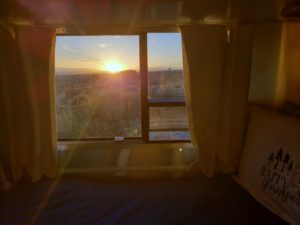
Day 9 Sunday, May 09, 2021
While we don’t have enough time in Bluff to give the trailer a full wash-down inside & out, we can at least get ourselves clean again, after the red sand got everywhere. By midday we’re off towards the next stop on our route: Hovenweep National Monument.
Just a little over an hour east, following some pothole and gravel roads, we reach this little gem just before the border to Colorado. The 31-site first-come-first-serve campground has a few sites blocked out for COVID distancing, but still a few open ones for us to chose from. Site #4 will be our home for the next 3 days.
Day 10 Monday, May 10, 2021
The main part of today is a drive to Cortez, CO, to restock some supplies – while also taking the tour around the Canyons of the Ancients National Monument, located in Colorado between Hovenweep and Cortez.
Before returning to the campsite however, we explore one of the rugged sand roads into the desert and find the Holly group of towers, isolated miles from the Square Tower group near the campground and visitor center. Just us, towers and petroglyphs – before heading back to our site.
What is in a name?
Hovenweep means “deserted valley” in the local (Ute/Paiute) native tribes’ language and was named so by pioneering photographer William Henry Jackson in 1874. It was recommended for protection in 1917-18 and proclaimed a National Monument in 1923 by President Harding. The canyon and mesa country north of the San Juan River holds many archeological sites where.
Ancestors of today’s Pueblo India tribes lived. Round, square, and D-shaped towers grouped at canyon heads most visibly mark once-thriving communities. No one has lived in them for over 700 years, but they are still inspiring. Many dwellings stood right at the canyon rim, and some structures were built atop isolated or irregular boulders – not practical sites for safety and access. Most are associated with springs and seeps near canyon heads. Such locations suggest that the ancestral Pueblo people were protecting something, if not themselves then perhaps the water – extremely valuable to desert-dwelling agriculturalists. By the late 1200s, prolonged drought, overuse of natural resources, and, possibly, internal strife led to the eventual abandonment of the region. The people settled in what are now known the pueblos of the Rio Grande valley in New Mexico and the Hopi mesas of Arizona.
Day 11 Tuesday, May 11, 2021
Hovenweep’s Little Ruin Canyon Trail starts near the Campground, and dogs are allowed so on we go!
Population density at Hovenweep varied over time. In the 1200s, people built pit houses, pueblos, ceremonial rooms (kivas) and the towers that are Hovenweep’s trademark. Most of the buildings here still standing were constructed from 1230 to 1275 CE (Common Era), about the same time as the famous cliff dwellings at Mesa Verde National Park. The Square Tower group sits in the heart of a 500-square mile raised block of land called Cajon Mesa and is part of the Great Sage Plain. Several streams drain the mesa and flow into the San Juan River to the south.
Starting counterclockwise along the rim trail we pass the Stronghold House and Unit Type House, get a view of the Eroded Bolder House across the canyon, take the Tower Point detour before reaching Hovenweep Castle. The Square Tower and Hovenweep House are next, already on the far side of the canyon after having passed the Checkdam. Rim Rock House and Twin Towers finish off the sights before we descend into the Little Ruin Canyon and back up on the Campground side to return to our starting point.
What’s in a name?
The name Anasazi has long been used for the prehistoric farmers of the Four Corners. The favored term now is ancestral Puebloan, indicating they were the ancestors of modern-day Puebloans. Many Pueblo people maintain physical and spiritual connections to these places.
CE (Common Era) and BCE (Before Common Era) replace BC and AD.
Day 12 Wednesday, May 12, 2021
Too soon it’s time to pack back up and head west to Blanding, UT, where we’ll refuel for the next 36 hours before our next off-the-grid destination. But first, let’s get scrubbing! Kirk gives the truck & trailer a bubble bath in the local car wash while J.T. and I tackle the Bambi’s inside. The rough road back to town shook lose some more dust and dirt from Valley of the Gods, and it clean every surface I can find!
Shiny inside and out, we grab the last available site at the Blue Mountain RV Park just south of town, and while Kirk gets set up, I take to the local Laundromat. Exciting day!
Day 13 Thursday, May 13, 2021
Today is a catch-up day … all things needing WIFI access and/or a laptop get done today, including updating the blog, editing our videos and more.
Plus some local sightseeing – including a visit to the local Dinosaur Museum – it’s ok – as well as the Edge of the Cedars State Park and Museum. This one is actually very interesting to visit, including a climb down a ladder into a 1,000-year-old Puebloan kiva, as the park features the partly-restored remains of a village inhabited from AD 825 to 1225 by the ancestors of contemporary Puebloan peoples. The museum is home to one of the largest collections of Ancestral Puebloan (Anasazi) pottery on display in the Four Corners area.
And then we got some ice cream!














































Rita Ann
Flowers: pic #3 is a globemallow, 14 is larkspur (I think), 17 is desert paintbrush.
Rita Ann
Oh, and 16 is Mormon Tea.